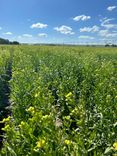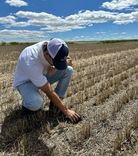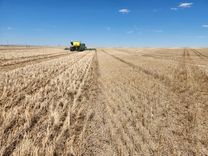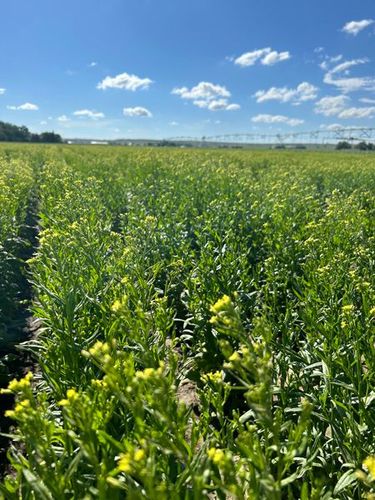Oilseed on the Rise






Camelina sativa is a low-carbon and high-energy oilseed, boasting uses for both the seed's oil content and plant meal. IMAGE: ASH CREEK RENEWABLES
May 27, 2025
BY Caitlin Scheresky
John Cusick has seen many doors open and close in his 20-year career in biofuels. The most recent of these has been the opportunity to serve as CEO of Ash Creek Renewables, a renewable fuel feedstock startup based in Connecticut. ACR is making steady progress, its most recent milestone being the securing of exclusive licensing rights from Montana State University for a high-performance camelina seed variety.
Camelina (Camelina sativa) is a nonfood oilseed variety that is low-carbon and high-energy, requiring very little input and providing a secondary revenue stream for farmers. Camelina shows significant drought and spring freezing tolerance, a resistance to flea beetles, and potential to serve as a beneficial addition to small grain crop rotations, according to MSU. And ACR is just getting started. “We were patient to share what we’ve come up with and what we think we have until we got there,” Cusick says. “We effectively have one of the two new camelina seed licenses Montana State has developed and issued into the private sector, with Sustainable Oils, who has been in Montana for 13 years, getting the other one.
“That was a very big win for a new company and market entrant,” Cusick says. “But the real win for us isn’t the license as much as the opportunity we found for the [camelina] industry with the bioplastics IP, because that is what unlocks the opportunity to scale camelina and create meaningful volumes of camelina oil to decarbonize aviation fuel.”
Maneuvering the Field
Ash Creek’s story begins with Cusick’s previous work in the biomass-based diesel veins of several commodity and renewable energy companies. Many of the insights he’d learn on the business and trade side of the industry would carry into his next venture as a senior analyst and co-owner of The Jacobsen Publishing. “I’m a biodiesel caveman who’s trying to find his way into the innovative future of the world,” Cusick says. “I have a lot of history and experience running large biodiesel trading, large ag reach, heavy trading boots, and dancing amongst the credits and all the various moving pieces of that world for most of my career.
“Ash Creek was founded as I was selling The Jacobsen,” he continues. “While I was doing that, I was starting to get some feelers from the usual recruiters, and there were a bunch of jobs starting to pop up for strategy guys who understood feedstock markets and renewable fuels.”
Cusick called on his connections in private equity from his time at The Jacobsen, resulting in ACR. A young startup, ACR put its eggs in several baskets of interest; this broad excitement paid off when Tailwater Capital, a private equity firm, absorbed ACR. “I had this really amazing couple of years of work with The Jacobsen that parlayed beautifully into strategy and insights into how to build the midstream company between those converted sustainable aviation fuel (SAF) and [renewable diesel] refineries and the feedstock origination,” he says. “So that was our very narrow focus with Ash Creek. The shift in biomass was diesel to biodiesel to renewable diesel and into SAF, and there were these huge refineries being converted that have traditionally been fed by pipelines and big ships,” he explains. “These whole new supply chains would need to be created to feed these other agricultural inputs, so that was the thesis.”
Advertisement
To begin with, ACR worked on soybean oil. “We had an enzymatic process on the Mississippi River for soybean oil, and we were taking all the metals out of crude soybean oil, making it perfect for renewable diesel, shipping it down to Diamond Green,” Cusick continues. A significant drop in the soy industry due to Low Carbon Fuel Standard credits crashing encouraged ACR to switch its focus to something greater.
“We started ... at 10 feedstocks, and where we are two years later is looking at two,” Cusick says. “We’ve narrowed our focus to used cooking oil because it’s so relevant and so highly valued, and it’s liquid so we can participate today. And then the other high mark we went to is camelina—that’s been something I’ve been excited about since 2007.”
Cusick cites ACR’s next-generation feedstock lead, Mike Logan, as crucial to the success of ACR and its acquisition of camelina. “We came in [to Ash Creek] with a really, really strong team and set of practical experience that we thought was unique in the market, and we continued to build that out over the past couple years,” Cusick says.
A Seed of Many Uses
Camelina has been a hot topic at MSU since its first appearance on campus in 2004 when the Montana Agricultural Experiment Station, a team of faculty and staff focused on crop and animal production research and outreach programs, began its initial work on the crop. MSU’s focus on the oilseed has been broad since the start, and its work has resulted in the earning of several grants in the process. “We believe [camelina’s] necessary. We believe that to decarbonize stuff, you must have the readily available starting points like camelina catch on fire, because the food versus fuel debate will stop SAF, and there aren’t enough waste oils that can be protected from fraud and supply chain authenticity,” Cusick says. “It’s gotta be camelina. I don’t see another option. I don’t know what camelina’s lifespan is before something better comes, but it’s the only thing that’s baked into EPA pathways, and it’s the logical starting point right now.”
It’s camelina’s oil percentage that truly sets it apart from other oilseeds. MSU reports a 30% to 40% oil content on a dry matter basis, which offers a pathway to biofuel production for tracks like SAF. But despite its impressive numbers, the seed’s oil content doesn’t solve everything—it instead makes things a little more interesting. “It’s impossible to scale camelina oil purely on the available credit stack that’s there today,” Cusick explains. “Now, the credit stack started to really shine 10 years ago, when the carbon intensity (CI) value of 16 was attributed to camelina bicarb. That’s when the lights came on for camelina.”
This uphill climb to scalability has led ACR to turn to the rest of the crop to find a balance. The plant meal, too, has potential to serve several areas, including animal food quality improvements, home heating and bioplastics, which Cusick says has become an encouraging area. “Luckily, those two things stand on their own feet where we’ve landed, and what we’ve found is that camelina meal makes an excellent bioplastics input.
Advertisement
“So, by us being able to buoy meal value and show that’s the answer to scale, others are going to chase us—others are going to follow us, innovate around and beyond us. We’re unlocking this to make this work now,” Cusick says.
ACR conducted successful pilot grows in 2024 and is increasing acreage in Montana and North Dakota this spring to grow its newly licensed, received variety, Logan adds. “And I think our original grow last year was super advantageous for us in regard to building a seed inventory, and also to create volume for us to do intense [research and development] into the meal and send down to our partners, Elementa Foods, in Argentina.”
Unexpected challenges have turned ACR into an evolutionary company, an added benefit from its young age. “Right now, quite frankly, it’s really hard to suggest super strong forward earnings from the biofuels market in America,” Cusick says. “So, if we can feed some hog farms and make some money off bioplastics this year, we look like smart guys in the room.”
Reap What You Sow
Receiving exclusive licensing rights for one of two seed varieties isn’t just impressive—it’s a badge of honor. “Ash Creek, two years old with [an initial appetite for] wide feedstock and strategy has now narrowed to yuca and camelina and positioned itself in a really exciting place amongst the present competitive landscape,” Cusick says.
ACR’s competition extends outside of the U.S. all the way to Argentina, where ACR’s partner, Elementa Foods, thrives. “Down there we’ve got Sustainable Oils, Dreyfus, Bungee and Chevron ... So what do we have that differentiates us as the smallest, least tenured player?” Cusick asks. “We’ve got a bunch of smart, creative people. We’ve got amazingly great partners around the U.S., companies like Eni, Macquarie, Tailwater Capital, partners like Montana Renewables, supporting us all along the way,” he says. “And so, you’ve got a really clear competitive landscape.”
For ACR, camelina meal is just as exciting as, if not more than, the oil. “We’re focused on the development of camelina and scaling the cultivation of camelina, and we see that being done by figuring out more innovative and genius ways to create a higher value for the meal,” Cusick explains. “And we have found one in bioplastics, but we’ve got three others we’re going to find, too. And we hope everybody chases us so that we can have camelina, 10 years from now, as a cover crop all over the globe.”
Author: Caitlin Scheresky
Junior Staff Writer, Biodiesel Magazine
Related Stories
The USDA maintained its outlook for 2025-’26 soybean oil use in biofuel production in its latest World Agricultural Supply and Demand Estimates report, released Aug. 12. The forecast for soybean oil prices was also unchanged.
U.S. soybean production for 2025 is forecast at 4.29 billion bushels, down 2% when compared to last year, according to the USDA National Agricultural Statistics Service’s latest monthly Crop Production report, released Aug. 12.
California’s new specified source feedstock attestation requirement: A critical new compliance step for renewable fuel producers
As of July 2025, California’s SCFS requires renewable fuel producers using specified source feedstocks to secure attestation letters reaching back to the point of origin. This marks a significant shift in compliance expectations.
At the University of Missouri, plant biochemist Jay Thelen is using arabidopsis as a powerful model to explore ways to boost oil production — an important step toward creating more sustainable, plant-based energy sources.
Iowa farmers have a new market opportunity for their 2025 soybean crop. Landus is expanding its Clean Fuel Regulation initiative, made possible by recent policy changes expected to increase Canada's demand for liquid biofuel.
Upcoming Events










